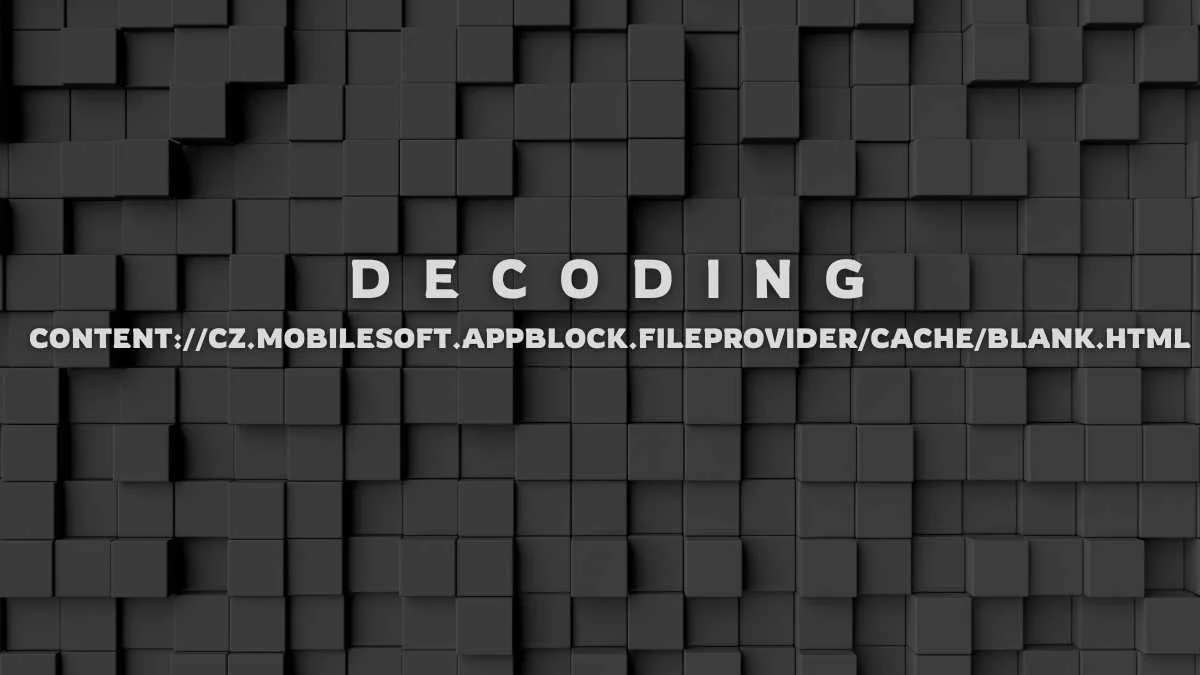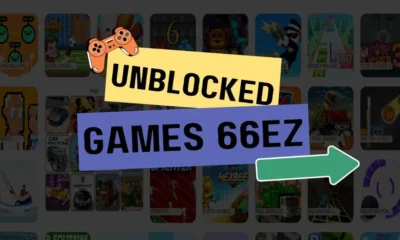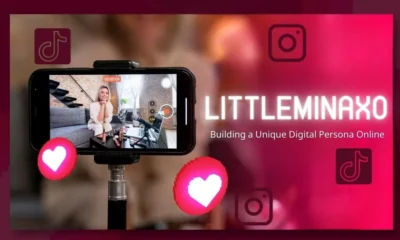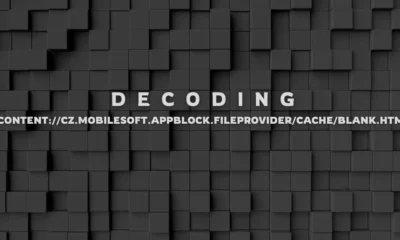TECHNOLOGY
Decoding content://cz.mobilesoft.appblock.fileprovider/cache/blank.html

The URI content://cz.mobilesoft.appblock.fileprovider/cache/blank.html refers to a blank HTML file that resides within AppBlock’s cache directory on Android devices. It is accessed via Android’s FileProvider, a secure content-sharing mechanism that allows apps to safely expose files to other apps without compromising user privacy or system integrity. AppBlock leverages this feature to control and redirect content displayed within blocked applications or web views, effectively replacing them with a minimal, distraction-free blank page.
content://cz.mobilesoft.appblock.fileprovider/cache/blank.html URI doesn’t point to a traditional web-based resource but rather to a local cached file on the device. Its sole purpose is functional—to neutralize distractions in the most lightweight and non-intrusive way possible.
What is a FileProvider?
A FileProvider is an Android component that enables apps to share their files securely with the help of content URIs rather than file paths. It is a principal component of contemporary Android privacy policies, ensuring that applications do not unintentionally disclose sensitive data. It is an abstraction layer that provides temporary, secure access to files stored in the personal directories of an app.
READ ALSO: Appfordown: Centralized App Download & Management
Anatomy of the URI content://cz.mobilesoft.appblock.fileprovider/cache/blank.html
This URI breaks down as follows:
- content:// – Denotes a content URI scheme.
- mobilesoft. app block.fileprovider – The authority declaring the FileProvider.
- /cache/blank.html – The path to the blank HTML file stored in the app’s cache directory.
Redirecting Web Content Using blank.html
AppBlock redirects to such a blank page when the application communicates with a blocked site on a web view or in-app browser, typically using the URI content://cz.mobilesoft.appblock.fileprovider/cache/blank.html. This leads to:
- The user has nothing but a blank screen.
- It sends the mental cue of the psychological access denied but with no jarring errors.
- The app does not clutter the user experience and is still performing its goal of distraction blocking.
Key Features of URI Mechanism
- Smooth Redirection: Rather than blocking access to a site or app visibly, AppBlock redirects it to an empty page, so the interface is not destabilized.
- Local Resource Usage: Since the URI is the reference to a locally cached file, it does not have network-dependent or latency issues, which makes it faster and more reliable.
- Low System Overhead: The barebones, cached HTML uses few resources and never interferes with battery and processing resources.
- Developer Customizability: Developers can extend the Android Open FileProvider framework to implement comparable mechanisms in any other custom productivity tool.
AppBlock vs Other Distraction-Blocking Apps
| Feature | AppBlock (MobileSoft) | Stay Focused | Forest |
| URI-Based Redirection | Yes – Uses content URI to display blank HTML | No – Uses time-based app limits | No – Focuses on gamification with tree planting |
| FileProvider Integration | Yes – Compliant with Android’s modern file sharing | No | No |
| Cached HTML Usage | Yes – Ensures fast, offline-friendly redirection | No – No content redirection method used | N/A – Doesn’t use web blocking |
| Lightweight System Resource Usage | High – Blank HTML page, no network dependency | Medium – Multiple background processes | Medium – Graphics and UI components in use |
| Silent Blocking Mechanism | Yes – No warnings or alerts, just redirection | Partial – Pop-up notifications | No – No site blocking |
| Focus Enforcement | Passive – Via environment control (blank pages) | Active – Timers and limits | Gamified – The Tree dies if focus breaks |
URI-Based Blocking – A Smarter Alternative
This way is neither as obtrusive as the blocking applications that shut down and turn off an entire application nor as disruptive as alert-setting programs. It might even happen that the user is oblivious to a distraction that was effectively prevented; in fact, they just appear before a non-workable portal.
In AppBlock’s case, this portal is often the blank.html page accessed via the URI content://cz.mobilesoft.appblock.fileprovider/cache/blank.html, which silently replaces distracting content with a blank screen. This non-confrontational style has less psychological resistance and is more adherent. More importantly, it keeps devices privacy-safe and performance-enhanced.
Actionable Use Cases
- Student Exam Prep: Block social media apps/websites while studying.
- Workplace Focus Sessions: During intense projects or work sprints.
- Mindful Breaks: Schedule time slots where all content except meditation or wellness apps are blocked.
- Parental Control: Replace unnecessary access with an unobtrusive blank screen.
The Role of Cache Files in Android App Efficiency
Android applications require interventions in the form of cache files to enhance their performance and responsiveness. Apps can minimize their use of resources and loading time by caching commonly used information locally. When implementing AppBlock, one puts the blank.html file into the app cache directory, after which it can be easily accessed at any time, one must redirect.
This is achieved using the URI content://cz.mobilesoft.appblock.fileprovider/cache/blank.html, which allows the file to be retrieved instantly through Android’s secure FileProvider system. This prevents delays that would have been caused when the content has to be fetched or recreated every time, which makes the experience smooth and non-obtrusive to the user.
Security Considerations with FileProvider
To preserve the user data, Android maintains a tightly controlled policy regarding file access, and as of Android 7.0 (API level 24), inter-app direct sharing of file paths is prohibited. To respond to this, developers make use of FileProvider, a safe element with the capacity to enable the sharing of files via content URIs in apps. The AppBlock uses it and defines a content URI such as content://cz.mobilesoft.appblock.fileprovider/cache/blank.html to point to blank.html.
Not only does this mechanism keep the internal structure of file paths secret, but it also makes the data read-only, which would exclude possible modification or improper use. AppBlock is privacy-driven and policy-compliant, which falls in line with the latest in Android security architecture; as such, it is not only safe but also trustworthy on a day-to-day basis.
Conclusion
The URI content://cz.mobilesoft.appblock.fileprovider/cache/blank.html might appear purely technical at first, but its implications are deeply practical and behavioral. Used effectively by AppBlock, this mechanism illustrates the thoughtful design behind modern digital wellness tools.
By rerouting users away from distractions toward a blank space, AppBlock not only preserves system functionality but also fosters the discipline needed to stay focused in a digital world brimming with interruptions. This silent guardian—a blank HTML file content://cz.mobilesoft.appblock.fileprovider/cache/blank.html —is doing the heavy lifting in reshaping attention spans, enabling healthier digital habits, and empowering users to reclaim control over their time.
-

 BIOGRAPHY6 months ago
BIOGRAPHY6 months agoBehind the Scenes with Sandra Orlow: An Exclusive Interview
-

 HOME1 year ago
HOME1 year agoDiscovering Insights: A Deep Dive into the //vital-mag.net blog
-

 HOME1 year ago
HOME1 year agoSifangds in Action: Real-Life Applications and Success Stories
-

 BIOGRAPHY1 year ago
BIOGRAPHY1 year agoThe Woman Behind the Comedian: Meet Andrew Santino Wife




























